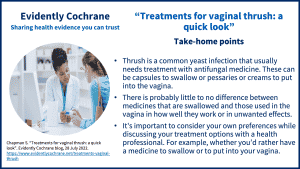In this short blog, Sarah Chapman looks at the evidence on treatments for vaginal thrush and what else might matter to you when looking for a treatmentSomething done with the aim of improving health or relieving suffering. For example, medicines, surgery, psychological and physical therapies, diet and exercise changes. for it.
Take-home points

The evidence comes from two Cochrane ReviewsCochrane Reviews are systematic reviews. In systematic reviews we search for and summarize studies that answer a specific research question (e.g. is paracetamol effective and safe for treating back pain?). The studies are identified, assessed, and summarized by using a systematic and predefined approach. They inform recommendations for healthcare and research.* and is relevant to women with vaginal thrush, except women who are HIV positive, immunocompromised, pregnant, breastfeeding or have diabetes, as the research studies excluded them.
What is thrush?
Thrush is a common yeast infection that affects women and men. It’s usually harmless but can be uncomfortable, and it can keep coming back. Thrush can cause symptoms such as itching and a white discharge from the vagina or penis, but it can also affect other areas of skin such as the armpits and groin.
How is thrush treated?
Usually with antifungal medicine (often this is fluconazole in capsules and clotrimazole in creams). Antifungal medicines can be capsules to swallow, or put into the vagina as pessaries or creams.
NHS advice is to see your GP if you have thrush symptoms for the first time, but that you can buy an antifungal medicine from a pharmacy if you’ve had thrush before and know the symptoms. You can also ask to speak with a pharmacist if you have questions.
Partners don’t need to have treatment unless they have symptoms.
Making a choice? Think BRAIN!
It can be helpful to think BRAIN: What are the Benefits, Risks, Alternatives, what do I want and what if I do Nothing? These can be good questions to talk about with the health professional you see. This could be a pharmacist, a nurse at the sexual health clinic, an advanced clinical practitioner at your GP surgery, or a GP.
What are the benefits of using antifungals and how do the different methods compare?
The evidence says there is probably little to no difference between antifungal treatments taken by mouth or in the vagina for getting rid of symptoms. There may be little to no difference between them in how quickly thrush clears up.
For people who keep getting thrush, there is some evidence that treatment with antifungals is better than no treatment. It’s uncertain whether treatment by mouth or by vagina is better.
Are there any risks of using antifungals?
Any treatment can have unwanted effects.
The evidence says it may make little to no difference to the riskA way of expressing the chance of an event taking place, expressed as the number of events divided by the total number of observations or people. It can be stated as ‘the chance of falling were one in four’ (1/4 = 25%). This measure is good no matter the incidence of events i.e. common or infrequent. of unwanted effects whether you have an antifungal by mouth or in your vagina.
Just 3 of the 5000 women taking part in the research studies stopped taking antifungals because of unwanted effects.
Antifungals put into the vagina commonly affected only the vaginal area, while it was more common to have a headache or digestive symptoms with antifungals taken by mouth.
What are the alternatives?
You may have a choice between medicines to swallow and pessaries and/or creams to put in your vagina. Some women choose to use probiotics as well but the Cochrane Review Probiotics for vulvovaginal candidiasis in non-pregnant women (published November 2017) found there is a lack of reliable evidence about their effects for women with thrush.
What are your individual preferences and experiences?
You may prefer to contact your health centre, a sexual health clinic or (if you’ve had thrush diagnosed before) a pharmacist for advice and treatment. You can discuss with them your experiences of previous treatment and whether you’d rather have a medicine to swallow or to put into your vagina.
What if you do nothing?
NHS advice is that you’ll usually need antifungal medicine to get rid of thrush. It should then clear up in one to two weeks.
Practical tips and resources
The NHS website has more trustworthy information about thrush, including things you can do to be more comfortable and to make it less likely to come back.
If you have questions, you could speak with your pharmacist, or a health professional at a sexual health clinic staff or GP practice.
*The evidence comes from these Cochrane Reviews:
Cooke G, Watson C, Deckx L, Pirotta M, Smith J, van Driel ML. Treatment for recurrent vulvovaginal candidiasis (thrush). Cochrane Database of Systematic ReviewsIn systematic reviews we search for and summarize studies that answer a specific research question (e.g. is paracetamol effective and safe for treating back pain?). The studies are identified, assessed, and summarized by using a systematic and predefined approach. They inform recommendations for healthcare and research. 2022, Issue 1. Art. No.: CD009151. DOI: 10.1002/14651858.CD009151.pub2.
Denison HJ, Worswick J, Bond CM, Grimshaw JM, Mayhew A, Gnani Ramadoss S, Robertson C, Schaafsma ME, Watson MC. Oral versus intra-vaginal imidazole and triazole anti‐fungal treatment of uncomplicated vulvovaginal candidiasis (thrush). Cochrane Database of Systematic Reviews 2020, Issue 8. Art. No.: CD002845
Xie HY, Feng D, Wei DM, Mei L, Chen H, Wang X, Fang F. Probiotics for vulvovaginal candidiasis in non-pregnant women. Cochrane Database of Systematic Reviews 2017, Issue 11. Art. No.: CD010496. DOI: 10.1002/14651858.CD010496.pub2. Accessed 11 July 2022.
See also:
NHS. Thrush in men and women. NHS.UK, page last reviewed 27 October 2020. Web. 28 July 2022. https://www.nhs.uk/conditions/thrush-in-men-and-women/
Why you can trust this information
With thanks to GP Dr Robert Walton for his input.
Join in the conversation on Twitter with @CochraneUK @SarahChapman30 or leave a comment on the blog.
Please note, we cannot give specific medical advice and do not publish comments that link to individual pages requesting donations or to commercial sites, or appear to endorse commercial products. We welcome diverse views and encourage discussion but we ask that comments are respectful and reserve the right to not publish any we consider offensive. Cochrane UK does not fact-check – or endorse – readers’ comments, including any treatments mentioned.
Sarah Chapman has nothing to disclose.


